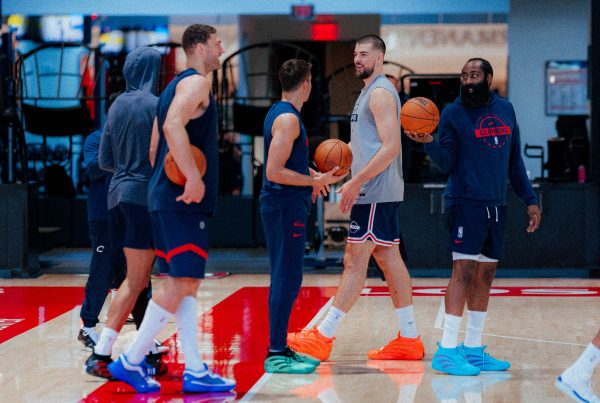Today, we’re looking at a season preview for veteran stretch 4 Patrick Patterson, who recently re-signed with the Clippers on a one-year deal to play a bigger role on the team’s second unit.
Basic Information
Height: 6’8″
Weight: 235 lbs
Position: PF
Age: 31
Years in NBA: 10
Key Stats: In 59 appearances last season, played 13.2 minutes per game and averaged 4.9 points and 2.6 rebounds. He was one of the league’s best volume and efficiency shooters, making 39% of his 10.5 attempts per 100 possessions.
Contract Status: Patterson signed a one-year deal with the Clippers worth $3,077,704 using his non-bird rights. He’ll have early bird rights next summer, but in the meantime has an implicit no-trade clause that allows him to veto any mid-season deal.
Expectations
We sort of have to assume that the Clippers consider Patterson a top-10 rotation player this season. There really isn’t any other way to explain why they rushed to give him an above-minimum deal considering their proximity to the hard cap–in fact, even if Patterson is slotted in for 16 minutes a game all season long, it still feels like a questionable choice.
Still, it’s the choice the Clippers made, and Patterson is the team’s presumptive 9th man heading into the season, though we’d hope that an addition like Nicolas Batum has a strong enough impact to pass him in the pecking order. He proved last season that he was a solid above-replacement-level backup power forward, and that’s what we’ll expect from him this season too in an increased role due to the departure of JaMychal Green in free agency. Patterson still isn’t likely going to be a mainstay for Ty Lue in the playoffs, but he should be a nightly contributor in the regular season on a much more consistent basis than last year.
Strengths
Almost exactly opposite of what I said in yesterday’s breakdown of Reggie Jackson, Patterson has one extreme strength that provides almost all of his on-court value: high-volume, high-efficiency three-point shooting. He made 39% of his 2.9 attempts per game in low minutes–exactly 12 power forwards and centers shot better on more than 100 attempts. On the floor, he gives the Clippers a consistent pick-and-pop option who functions without the ball in his hands, allowing him to actively participate in sets as a screener but also space the floor to create more room for the Clippers’ higher-profile offensive creators to operate.
There’s also a bit of intangible value brought by Patterson. He’s a smart, team-first veteran who made a name for himself earlier in his career as a versatile team defender and role player. Even though he’s evolved into more of an offensive player, he still knows how to operate within the defensive scheme and brings positive positioning. Also, last year he was a consummate professional through inconsistent minutes as players like Moe Harkless, JaMychal Green, and Marcus Morris cycled through the rotation ahead of him. While it’s always hard to glean from the outside, Patterson seems like an overall positive and stabilizing presence on a team that had a bit too much turmoil last season for anyone’s liking.
Weaknesses
Besides his shooting, there isn’t a ton that stands out as a big positive for Patterson, but he was solid in most areas last season. He’s not a great rebounder, and probably not good enough to be a consistent option as a small-ball center, but he pulled down 7 per 36 minutes. He isn’t an offensive creator or distributor who is going to do much with the ball in his hands, but that’s not asked of him in his role, and he’s shown a capability of making a simple extra pass to an open man.
It’s really defensively where Patterson’s utility is more situational. He doesn’t have the size to really anchor a unit and protect the rim, and his foot speed just isn’t there to defend on the perimeter. The Clippers could struggle this season against teams that play smaller power forwards, especially on the second unit, and we might see someone like Nicolas Batum see more minutes in certain match-ups. Last season, Doc Rivers preferred to use Patterson in games against teams like the Los Angeles Lakers, who start 2 big men, so his strength could be a deterrent to Anthony Davis. But in 3 pre-bubble games against the New Orleans Pelicans, who start Brandon Ingram at power forward, Patterson played just 12 total minutes.
Summary
In Patrick Patterson, the Clippers retained a solid regular season contributor who will help them maintain their preferred offensive look, spacing the floor at power forward to provide more room for Paul George and Kawhi Leonard to drive into the lane. However, going above the vet’s min may have been a questionable decision considering the hard cap. Ultimately, Patterson’s upside this season is likely emerging as a clear and consistent 9th man, while his downside is sliding back into an 11th man role with Ty Lue opting for a smaller second unit. The likely deciding factor will be his defensive versatility, and whether or not he’s mobile enough to consistently guard the younger, faster forwards he’ll face on most opposing benches.
213Hoops is an independently owned and operated L.A. Clippers blog by Clippers fans, for Clippers fans. If you enjoy our content, please consider subscribing to our Patreon. Subscriptions start at $1 a month and support from readers like you goes a long way towards helping us keep 213Hoops sustainable, growing, and thriving.



